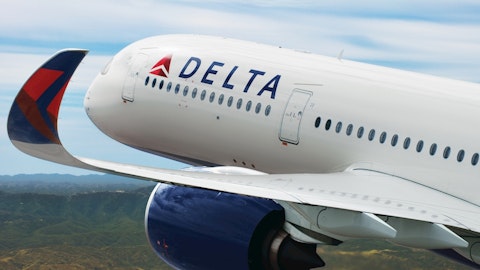Catherine O’Brien: Helpful. Thank you.
Operator: And our next question will come from Dan McKenzie with Seaport Global.
Dan McKenzie: Hey. Thanks. Good morning guys. Andrew, when I look at Alaska’s network in California, it looks like the state is only about 80% recovered relative to the footprint that was there in 2019. So, it looks like a pretty big revenue hole that has yet to recover. And if I am not mistaken, I believe it accounts for about 23% of Alaska seats. So, my question really is that, that part of the network were fully restored, what is the size of that revenue hole that could eventually go away, or however you can size it would be helpful.
Andrew Harrison: Well, I think if I am understanding your question, Dan, I think again, we are not going to put seats into a state where there is no demand. So, your observations are absolutely correct as far as capacity, and we are down. And I think other carriers are down as well. I think what I am still seeing here is even on tech and non-tech, and I repeat non-tech business recovery has not been as good at all versus what’s happening in the Pacific Northwest. So, we are going to – again, we talked about the network, we are going to be very disciplined and thoughtful about how we maintain our network and where we fly our seats. But again, as we have maintained for some time, I don’t think that’s going to be forever, and we are going to be very prepared and in a good position as demand begins to strengthen and crawl back up that demand curve back to 2019 levels to be able to serve that demand.
Dan McKenzie: Yes. Understood. And then, Shane, I think I might risk of kicking a dead horse here. My question is really the same as others here, and that’s just to – really just to close the circle on the path back to low-double digit pretax margin. I think you touched on fleet commonality at $75 million. It looks like Maui annualized might be close to $80 million or so. So, it looks like maybe 1.5 points to pretax margins there, or please correct me. But from where you sit, what are the biggest revenue and cost opportunities that get you where you want to be?
Shane Tackett: Thanks Dan. And I want to underscore what Andrew said a second ago, just so we don’t lose the point. One of the things I think you all should be thinking about in terms of Alaska setup is we are still in the least recovered portion of the country and still fighting for industry’s best margins. So, I just think there is goodness to come overall for the company. In terms of your question, yes, the cost side is really leaning out the company, getting rid of the – not all of the buffer we have put in, but starting to work that back, getting closer to the 2019 productivity levels. I think there is opportunity to further leverage technology and automate more of what the guests do, and we are certainly going to be working on that over the next few years as I think every company is going to be doing.
On the revenue side, like once we see sort of where demand normalizes, and in addition to the recovery we expect in the international demand or international-domestic demand mix in the West Coast recovery and business recovery, there is a lot more that Andrew and his team are starting to think about and look at from a commercial initiative perspective. They have done a great job delivering, and we don’t get to talk a lot about them on the calls, but delivering on many initiatives this year, we are selling things like exit row seats now that we have not done before, a huge uptick in first class and premium class load factors while yields in those cabins are going up. That is both demand and things that the e-commerce and distribution and pricing team are doing.
And there is more of those types of things that we are thinking about for the next year or 2 years. And we will talk more about that as we firm plans up and include them in our guidance and/or get to an Investor Day at some point in 2024.
Dan McKenzie: Yes. Pretty good. Thanks for the time guys.
Ryan St. John: Thanks Dan and thanks everyone for joining us for our call. We will see you next – or talk to you next quarter. For those we didn’t get to, our IR team will be in contact with you. Thanks everybody.
Operator: This concludes today’s conference call. Thank you for attending.
Follow Alaska Air Group Inc. (NYSE:ALK)
Follow Alaska Air Group Inc. (NYSE:ALK)
Receive real-time insider trading and news alerts




